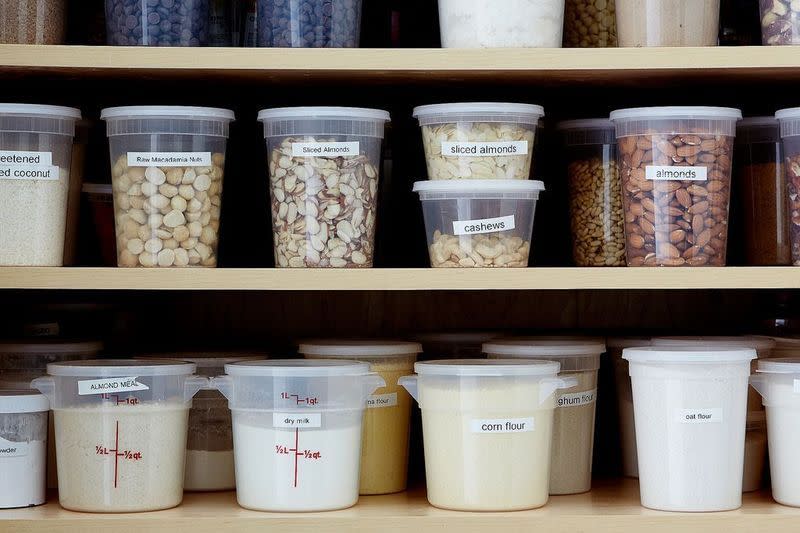The Sure-Fire Best Ways to Store Leftovers to Ensure They Last
In the spirit of abundance, cooking at home almost always results in an array of leftovers: already-mixed salads, dinner rolls and breakfast biscuits, cooked meats, extra granola, and half-full baking dishes of every side dish imaginable. The first best solution is to give as much as possible to dinner guests, and then to get creative with the rest (even if that’s just by using the ever-effective method of serving a flash-fried egg on top). But in both cases, how do you best store them in the mean time?
Related: 11 Grocery Store Items You Could Be Making at Home
We polled our editorial team for their best leftover strategies and came up with some tried and true ways to help you stay organized and well fed in 2016.

Weck jars offer airtight storage that’s cute enough to send home with guests. (Photo: James Ransom/Food52)
For Freezer-Safe Leftovers in Large Quantities: The Flat Baggie Method
For organization and easy access, I like freezing anything stewy or liquid—let’s say chicken broth, soup, mashed potatoes, or even granola (which freezes alarmingly well)—in quart-sized, freezer-safe plastic baggies. Label them with a permanent marker and tape, lay them flat in the freezer to solidify, and then stack them like inch-thick books in a neat little line.
Related: Why Leftovers Are a Logical, Lovable Kids’ Lunch
Then, when you feel like some mashed potatoes with dinner in February, just de-thaw as many of the baggies as you need to feed your crowd (or just you).
Related: How to Store Fresh Bread

Deli containers also double as excellent pantry organizers. (Photo: Mark Weinberg/Food52)
For Small Amounts: The Deli Container Method
According to our managing editor Kenzi Wilbur, deli containers—those round plastic vessels with tight-fitting lids that dumpling soup arrives in when you order takeout—are “not cute, but so functional.” Being transparent, lightweight, and inexpensive (not to mention excellent stackers), they’re what we use in the office when sending home leftovers from a photoshoot. In your own home, they’re great for storing a small amount of any leftover (like those last five bites of steak that nobody finishes), or things that wouldn’t freeze well, since you can standardize the amount and stack them in an orderly way.
Related: Mastering Leftovers
Our assistant editor Leslie uses so many deli storage containers that she decided to re-arrange her refrigerator shelves to best fit the stacked vessels “Once you’ve chosen your storage container, change around your fridge so that they work for you—and to maximize space!,” she says. If you prefer something a little classier, like glass containers with snap-on lids, the same system could be employed.
Related: 10 Ways to Use Up Your Leftover Champagne (If You Have Any, That Is)
For Giveaways: The Weck or Canning Jar Method
Our intern Taylor Rondestvedt noted, rounded glass Weck jars double as bowls when you’re ready to consume what’s in them. Plus, they’re airtight and cute—a combo that’s ideal for food you want to send home with guests (we might take home all kinds of deli containers from our office, but they’re really not the most attractive thing to pass off as a gift at the end of a night). Stock up on small and larger sizes so you’re ready to send home as much food as you want to get off your hands.
Related: How to Get Smells and Stains Out of Tupperware

Wash greens, dry on paper towels, then roll up and store in gallon-sized plastic baggies. (Photo: Food52)
For Fresh Ingredients: The Bagged Paper Towel Method
“I layer greens and washed herbs between layers of paper towel in gallon-size plastic bags,” says our co-founder Amanda Hesser, who also recommends pressing all the air out before zipping them up. Not only is this an effective means of keeping delicate ingredients perky for longer (“greens will stay nice this way for a week or more,” Amanda says), it’s also a great way to fill underused nooks in a stocked fridge, since the bags are light and flexible, as “they can fit either stacked in a vegetable drawer or on top of a container.”
In the event of more greens than a single bag can hold, opt to use a large plastic container in the same way.
By Amanda Sims.

